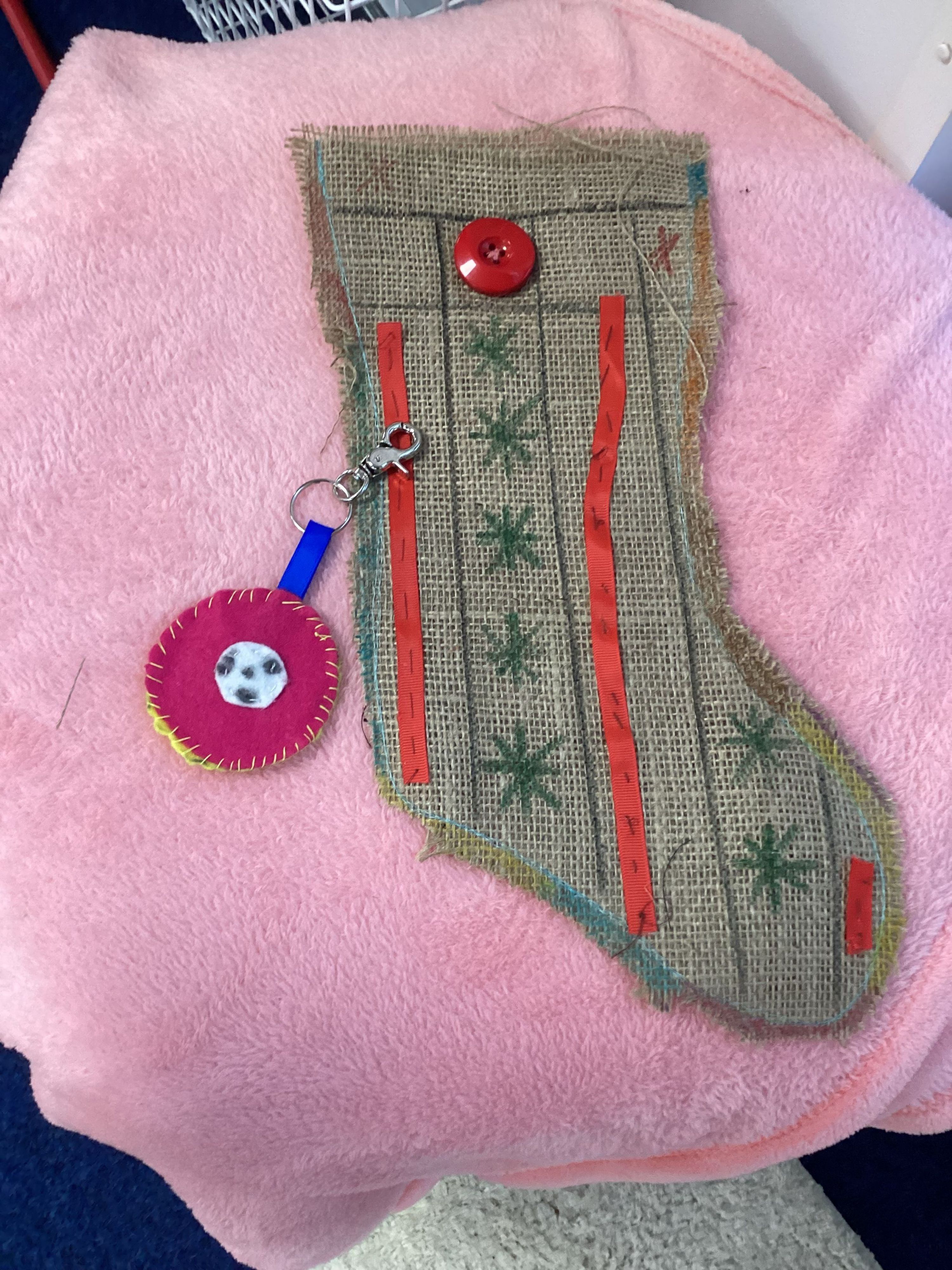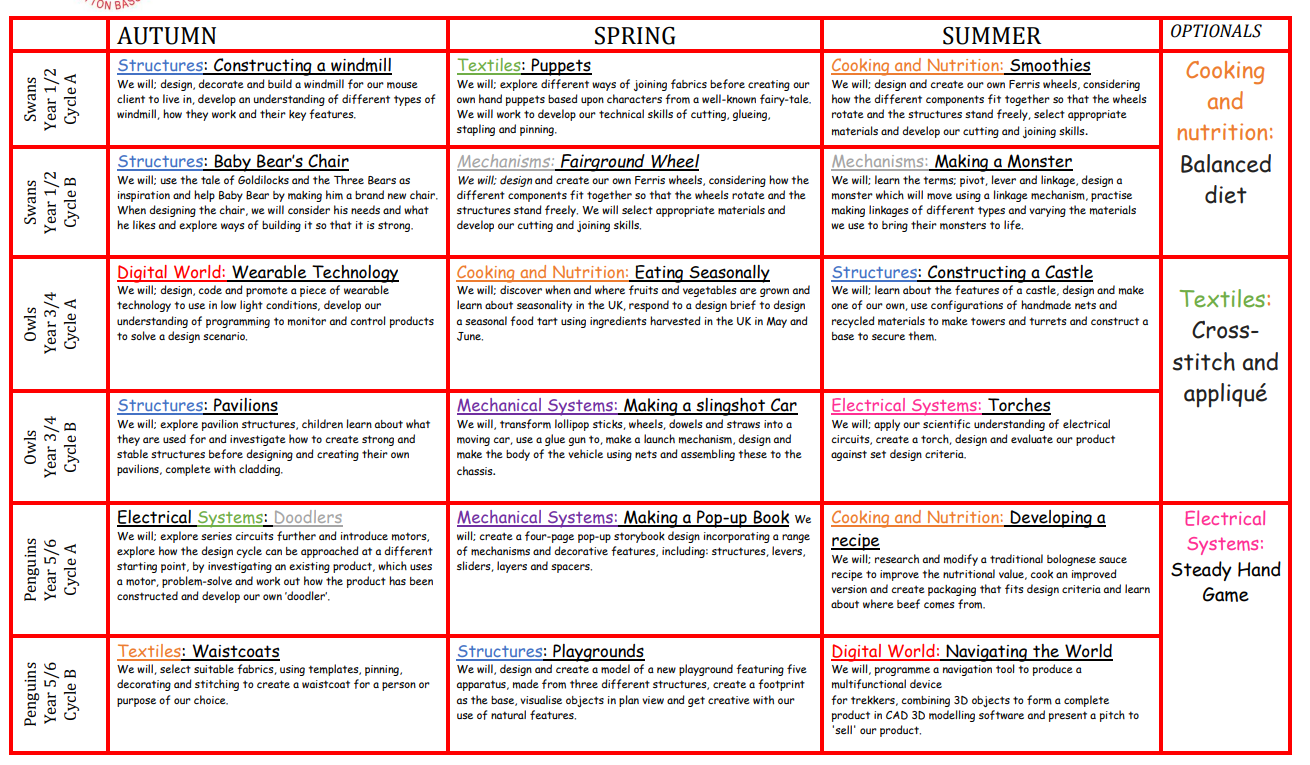Design Technology



Make Do and Mend - Year 5/6 - Textiles Unit

Pavilions - Year 3/4 - Structures Unit
Pavilions!
 Look at these fantastic pavilions children in Owls created! Their design brief was to create an interesting pavilion structure that allowed for sheltered space, outdoor space and space for recreation. They used glue guns, and a range of materials to bring their designs to life - we definitely have some budding architects in clas…
Look at these fantastic pavilions children in Owls created! Their design brief was to create an interesting pavilion structure that allowed for sheltered space, outdoor space and space for recreation. They used glue guns, and a range of materials to bring their designs to life - we definitely have some budding architects in clas…
We are Technologists!
 Penguins class have been using their science knowledge to create circuits for a 'steady-hand' game.
Penguins class have been using their science knowledge to create circuits for a 'steady-hand' game.
Intent
Our Design and Technology curriculum is all about getting students to think creatively and be innovative. We want our pupils to get excited about the whole product design process, from brainstorming ideas to building and testing their creations, and then evaluating how they did. At Manor Primary Academy, we're all about giving students the confidence to take risks and learn from their mistakes, making them reflective learners who can critique their own work and others'.
Our program of study helps students understand the impact design and technology have on our lives and encourages them to be resourceful and enterprising. This way, they’ll have the skills to contribute to future design breakthroughs.
By following our curriculum, students will hit the key stage targets in the National Curriculum. The Early Years Foundation Stage (EYFS) units are designed to help younger students work towards the Development Matters statements and Early Learning Goals.
Implementation
The Design and Technology National curriculum outlines the three main stages of the design process: design, make and evaluate. Each stage of the design process is underpinned by technical knowledge which encompasses the contextual, historical, and technical understanding required for each strand. Cooking and nutrition* has a separate section, with a focus on specific principles, skills and techniques in food, including where food comes from, diet and seasonality. The National curriculum organises the Design and technology attainment targets under four subheadings: Design, Make, Evaluate, and Technical knowledge. We have taken these subheadings to be our curriculum strands:

Through our carefully designed curriculum, pupils respond to design briefs and scenarios that require consideration of the needs of others, developing their skills in the six key areas. Each of our key areas follows the design process (design, make and evaluate) and has a particular theme and focus from the technical knowledge or cooking and nutrition section of the curriculum. Our curriculum is a spiral curriculum, with key areas revisited again and again with increasing complexity, allowing pupils to revisit and build on their previous learning. Lessons incorporate a range of teaching strategies from independent tasks, paired and group work including practical hands-on, computer-based and inventive tasks. This variety means that lessons are engaging and appeal to those with a variety of learning styles. Differentiated guidance is available for every lesson to ensure that lessons can be accessed by all pupils and opportunities to stretch pupils’ learning are available when required. Knowledge organisers for each unit support pupils in building a foundation of factual knowledge by encouraging recall of key facts and vocabulary.
Impact
The impact of our curriculum is constantly monitored through both formative and summative assessment opportunities. Each lesson includes opportunities for teachers to assess pupils against the learning objectives. Furthermore, each unit has a unit quiz and knowledge catcher which can be used at the start and/ or end of the unit. After the implementation of our Design and technology curriculum, pupils should leave Manor Primary Academy equipped with a range of skills to enable them to succeed in their secondary education and be innovative and resourceful members of society. The expected impact of our Design Technology curriculum is that children will:
➔ Understand the functional and aesthetic properties of a range of materials and resources.
➔ Understand how to use and combine tools to carry out different processes for shaping, decorating, and manufacturing products.
➔ Build and apply a repertoire of skills, knowledge and understanding to produce high quality, innovative outcomes, including models, prototypes, CAD, and products to fulfil the needs of users, clients, and scenarios.
➔ Understand and apply the principles of healthy eating, diets, and recipes, including key processes, food groups and cooking equipment.
➔ Have an appreciation for key individuals, inventions, and events in history and of today that impact our world.
➔ Recognise where our decisions can impact the wider world in terms of community, social and environmental issues.
➔ Self-evaluate and reflect on learning at different stages and identify areas to improve.
➔ Meet the end of key stage expectations outlined in the National curriculum for Design and technology.
➔ Meet the end of key stage expectations outlined in the National curriculum for Computing.
For this school year (2024-2025) we will be following Cycle A of our curriculum.
** Please note** We are in a transition period until the end of the academic year, so some units may be taught out of order to ensure full coverage over the two-year cycle.
Design Technology Long Term Plan

